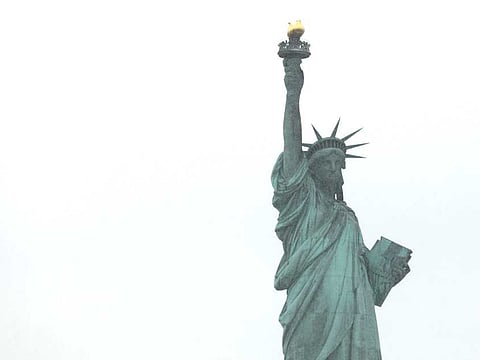America needs to return to national greatness
The true American myth is dynamic and universal, but the one that Trump has injected into the national bloodstream is static and insular

The Library of Congress’ main building is one of the most magnificent buildings in Washington, or in the United States. It was built in a pivotal, tumultuous time. During the 23 years in the late 19th century that it took to design and build the structure, industrialisation had transformed America. More people immigrated to America than in the previous 250 years combined.
The building articulates the central animating idea that held a bursting, turbulent America together. That idea is best encapsulated in the mural under the dome of the main reading room. A series of monumental figures are depicted, each representing a great civilisation in human history and what that civilisation contributed to the human story.
It starts with a figure representing Egypt (written records) and then continues through Judea (religion), Greece (philosophy), Islam (physics), Italy (the fine arts), Germany (printing), Spain (discovery), England (literature), France (emancipation) and it culminates with America (science).
In that story, America is placed at the vanguard of the great human march of progress. America is the grateful inheritor of other people’s gifts. It has a spiritual connection to all people in all places, but also has an exceptional role. America culminates history. It advances a way of life and a democratic model that will provide people everywhere with dignity. The things Americans do are not for themselves only, but for all mankind.
This historical story was America’s true myth. When we are children, and also when we are adults, we learn our deepest truths through myth.
Myths don’t make a point or propose an argument. They inhabit us deeply and explain to us who we are. They capture how our own lives are connected to the universal sacred realities. In myth, the physical stuff in front of us is also a manifestation of something eternal, and our lives are seen in the context of some illimitable horizon.
That American myth was embraced and lived out by everybody from George Washington to Abraham Lincoln to Theodore Roosevelt to Ronald Reagan. It was wrestled with by John Winthrop and Walt Whitman. It gave America a mission in the world — to spread democracy and freedom. It gave Americans an attitude of welcome and graciousness, to embrace the huddled masses yearning to breathe free and to give them the scope by which to realise their powers.
But now the myth has been battered. It’s been bruised by an educational system that doesn’t teach civilisational history or real American history, but instead a shapeless multiculturalism. It’s been bruised by an intellectual culture that can’t imagine providence. It’s been bruised by people on the Left who are uncomfortable with patriotism and people on the Right who are uncomfortable with the federal government that is necessary to lead the American project.
The myth has been bruised, too, by the humiliations of Iraq and the financial crisis. By a cultural elite that ignored the plight of the working class and thus broke faith with the basic solidarity that binds a nation.
And so along come men like US President Donald Trump and Stephen Bannon, Trump’s chief strategist, with a countermyth. Their myth is an alien myth, frankly a Russian myth. It holds, as Russian reactionaries hold, that deep in the heartland are the pure folk who embody the pure soul of the country — who endure the suffering and make the bread. But the pure peasant soul is threatened. It is threatened by the cosmopolitan elites and by the corruption of foreign influence.
The true American myth is dynamic and universal — embracing strangers and seizing possibilities. The Russian myth that Trump and Bannon have injected into the national bloodstream is static and insular. It is about building walls, staying put. Their country is bound by its nostalgia, not its common future.
The odd thing is that the Trump-Bannon myth is winning. The policies that emanate from it are surprisingly popular. The refugee ban has a lot of support. Closing off trade is popular. Building the wall is a winning issue. The Trump and Bannon anschluss has exposed the hollowness of American patriotism. It has exposed how attenuated America’s vision of national greatness has become and how easy it was for Trump and Bannon to replace a youthful vision of American greatness with a reactionary, alien one.
America is in the midst of a great war of national identity. Americans thought they were in an ideological battle against radical Islam, but they are really fighting the national myths spread by Trump, Bannon, Russian President Vladimir Putin, France’s National Front leader Marine Le Pen and former leader of the United Kingdom Independence Party Nigel Farage.
Americans can argue about immigration and trade and foreign policy, but nothing will be right until they restore and revive the meaning of America. Are Americans still the purpose-driven experiment that Lincoln had described and Emma Lazarus had written about: Assigned by providence to spread democracy and prosperity; to welcome the stranger; to be brother and sister to the whole human race; and to look after one another because they are all important in this common project?
Or is America just another nation, hunkered down in a fearful world?
— New York Times News Service
David Brooks is the author of The Road to Character. He also teaches at Yale University and is a member of the American Academy of Arts and Sciences.
Sign up for the Daily Briefing
Get the latest news and updates straight to your inbox



